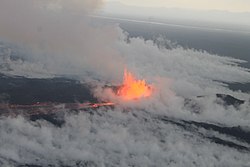Volcanoes in Iceland
Many volcanoes in Iceland are active volcanoes. This is due to its location on the mid-Atlantic Ridge which is a tectonic plate boundary. Iceland has 30 active volcanic systems. Of these, 13 have erupted since the settlement of Iceland in 874 AD.[1] The eruption under Eyjafjallajökull ("glacier of Eyjafjöll") in 2010 was notable because the volcanic ash plume disrupted air travel in northern Europe for several weeks.[2]
Volcanoes In Iceland Media
Volcanic and transform zones of Iceland - Legend::RR, Reykjanes Ridge; RVB, Reykjanes Volcanic Belt; WVZ, West Volcanic Zone; MIB, Mid-Iceland Belt; SISZ, South Iceland Seismic Zone; EVZ, East Volcanic Zone; SIVZ, South Iceland Volcanic Zone; NVZ, North Volcanic Zone; TFZ, Tjörnes Fracture Zone; KR, Kolbeinsey Ridge; ÖVB, Öræfajökul Volcanic Belt; SVB, Snæfellsnes Volcanic Belt.
Eruption column of Eyjafjallajökull in 2010
Eruptions at Holuhraun (Bárðarbunga-Veiðivötn volcanic system), 2014
The craters of Grábrók
2021 Fagradalsfjall volcanic eruption
ʻAʻā (apalhraun) field near Blue Lagoon
Pāhoehoe (helluhraun) lava fields in Iceland
References
- ↑ A (2008). "Postglacial Volcanism in Iceland". Jokull. 58: 197–228.
- ↑ Charles Q. Choi (8 February 2012). Why Iceland Volcano's Eruption Paralyzed Air Traffic/. http://www.nbcnews.com/id/46312726/ns/technology_and_science-science/t/why-iceland-volcanos-eruption-paralyzed-air-traffic/#.VHS_fIvF_UU. Retrieved 24 November 2014.









